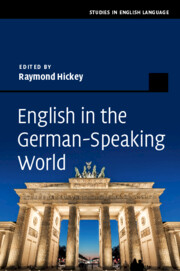Book contents
- English in the German-Speaking World
- Studies in English Language
- English in the German-Speaking World
- Copyright page
- Contents
- Figures
- Tables
- Contributors
- Preface
- Chapter 1 English in the German-Speaking World: The Nature and Scale of Language Influence
- I The Status of English
- II The Transmission of English
- III Domains and Features of English
- IV Beyond Germany
- Chapter 14 Varieties of English in the Netherlands and Germany
- Chapter 15 English in Austria: Policies and Practices
- Chapter 16 English in Switzerland
- Chapter 17 English and German in Namibia
- Chapter 18 English in German-Speaking Wisconsin and the Aftermath
- Chapter 19 The English ‘Infusion’ in Pennsylvania German
- Index
- References
Chapter 16 - English in Switzerland
from IV - Beyond Germany
Published online by Cambridge University Press: 11 November 2019
- English in the German-Speaking World
- Studies in English Language
- English in the German-Speaking World
- Copyright page
- Contents
- Figures
- Tables
- Contributors
- Preface
- Chapter 1 English in the German-Speaking World: The Nature and Scale of Language Influence
- I The Status of English
- II The Transmission of English
- III Domains and Features of English
- IV Beyond Germany
- Chapter 14 Varieties of English in the Netherlands and Germany
- Chapter 15 English in Austria: Policies and Practices
- Chapter 16 English in Switzerland
- Chapter 17 English and German in Namibia
- Chapter 18 English in German-Speaking Wisconsin and the Aftermath
- Chapter 19 The English ‘Infusion’ in Pennsylvania German
- Index
- References
Summary
The purpose of the present chapter is to investigate discourses on foreign language teaching and, in particular, the teaching of English in Switzerland, with a view to showing how these have come to play a significant, although inadvertent, socio-political role that potentially challenges Swiss national cohesion at the federal level.
- Type
- Chapter
- Information
- English in the German-Speaking World , pp. 315 - 333Publisher: Cambridge University PressPrint publication year: 2019

